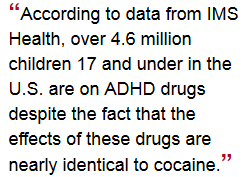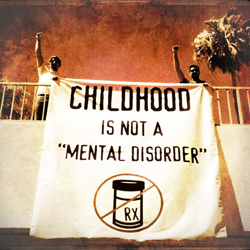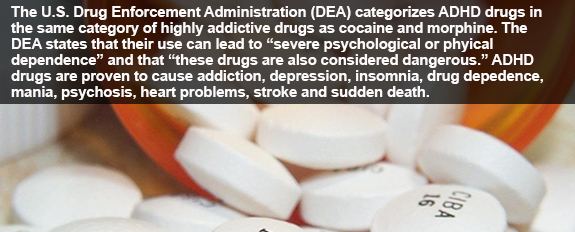Fraudulent Information being passed off under the guise of “ADHD Awareness,” Doesn’t Deserve the Time of Day, Let Alone a Month
By Kelly Patricia O’Meara – October 2013
October is ADHD Awareness Month. While clearly an attempt on the part of its supporters to gain legitimacy for the alleged psychiatric disorder, the facts actually reveal the fraud of the diagnosis as a medical condition requiring drugs to ‘treat it’.
Despite the best efforts of the leading pharmaceutically-funded ADHD organizations to convince the public that ADHD is “a real brain disorder,” the truth is that there simply is no known data to support that the alleged psychiatric disorder is an abnormality of the brain.
In what can only be described as pharmaceutically-funded propaganda, several of the better known ADHD organizations have begun a media campaign offering how to “Get the Facts” about ADHD.
Okay, getting the facts about ADHD seems like a good place to start. The problem for these ADHD organizations is that they don’t have any facts to support the ADHD brain abnormality mantra and openly admit this on their websites.
For example, the following is what each organization writes about the cause(s) of the “real brain disorder,” ADHD:
CHADD – Children and Adults with Attention-Deficit/Hyperactivity Disorder explains, “Although precise causes have not yet been identified…”
NAMI – National Alliance on Mental Illness says, “While we don’t know for sure what causes ADHD…”
ADDA – Attention Deficit Disorder Association explains, “ADHD IS very likely caused by…”
NIMH – National Institute of Mental Health says that “Scientists are not sure what causes ADHD…”
Given the above examples of the country’s top ADHD organizations being completely clueless about the cause of the alleged “real brain disorder,” ADHD, one has to wonder why the ADHD Awareness website (which includes CHADD and ADDA as members of the coalition) would write, “Research shows that ADHD is the result of an imbalance of neurotransmitters in the brain.”
I t is precisely these kinds of fraudulent statements that make the lie that ADHD “is a real brain disorder” believable. Psychiatry has peddled the “chemical imbalance” theory for decades. The fact remains that there are no tests available to measure the chemical levels in the brain, let alone determine what are the correct levels for each individual. The tired “chemical imbalance” theory remains just that—a theory.
t is precisely these kinds of fraudulent statements that make the lie that ADHD “is a real brain disorder” believable. Psychiatry has peddled the “chemical imbalance” theory for decades. The fact remains that there are no tests available to measure the chemical levels in the brain, let alone determine what are the correct levels for each individual. The tired “chemical imbalance” theory remains just that—a theory.
According to Harvard Medical School psychiatrist, Dr. Joseph Glenmullen, while “there has been no shortage of alleged biochemical explanations for psychiatric conditions…not one has been proven. Quite the contrary. In every instance where such an imbalance was thought to have been found, it was later proven false.”
Oddly enough, despite the fact that the coalition clearly can’t agree on, or explain, what causes ADHD, the ADHD Awareness Month website has the unmitigated gall to write, “The debate about Attention-deficit/Hyperactivity Disorder is over. And the truth about ADHD is clear.”
Actually, nothing is “over” or “clear,” and given their own admissions about the cause(s) of ADHD, the word delusional comes to mind. After all, based on available information from the nation’s best ADHD organizations, there is no scientific proof that ADHD “is a real brain disorder.”
In fact, the National Institutes of Health Consensus Conference on ADHD concluded: “We do not have an independent, valid test for ADHD, and there are no data to indicate ADHD is due to a brain malfunction.”
Again, to the groups pushing the ADHD “is a real brain disorder” mantra, the facts are inconsequential. This is not surprising as science and medicine does not, and never has, fit into the psychiatric diagnosing equation.

Over 4.6 million children 17 and under in the U.S. are on ADHD drugs despite the fact that the effects of these drugs are nearly identical to cocaine (Source: IMS Health).
Perhaps, though, it is the comments of psychiatrist, Peter Breggin that best summarize the continuing fraud of the ADHD “is a real brain disorder” mantra. “Despite more than two hundred years of intensive research, no commonly diagnosed psychiatric disorders have been proven to be either genetic or biological in origin, including schizophrenia, major depression, manic-depressive disorder, the various anxiety disorders, and childhood disorders such as attention-deficit hyperactivity. At present there are no known biochemical imbalances in the brain of typical psychiatric patients — until they are given psychiatric drugs.”
“Until they are given psychiatric drugs.” This is where the fraud and facts of ADHD collide. Diagnosing the alleged psychiatric brain disorder, ADHD, is a cash cow for the pharmaceutical companies. In the last five years, alone, ADHD drugs account for nearly $40 billion in pharmaceutical profits in the U.S.
ADHD drugs like methylphenidate (Ritalin and Concerta) and amphetamine (Adderall) are listed by the Drug enforcement Administration (DEA) as Schedule II drugs along with morphine, opium, cocaine and the heroin substitute methadone.
The ADHD drugs long have been referred to as “kiddie cocaine” because, according to the DEA, “neither animals nor humans can tell the difference between cocaine, amphetamine, methamphetamine or methylphenidate” and methylphenidate produces “effects nearly identical to cocaine.”
According to data from IMS Health, over 4.6 million children 17 and under in the U.S. are on ADHD drugs despite the fact that the effects of these drugs are nearly identical to cocaine. Worse yet, the pharmaceutical companies that produce the ADHD drugs openly admit that not only do they not know what causes ADHD, but they further admit that they do not know how the drugs they produce for its “treatment” work in the brain.
Not surprisingly, these facts are not found on the numerous websites of the organizations that make up the coalition behind ADHD Awareness month. Nor do these organizations make available on their websites the pharmaceutical funding each has received to “get the facts” out about ADHD.
For example, ADDA has received funding from Shire pharmaceuticals (the maker of Adderall) from at least 2006.[1] And McNeil-Pediatrics, a Division of Ortho-McNeil-Janssen Pharmaceuticals, the maker of Concerta, supported an adult ADHD Summit held by ADDA and The HealthCentralNetwork.[2] Evelyn Polk Green, the President of ADDA, was a paid speaker and consultant for McNeil Pediatrics as of 2012.[3] Shire also donated $123,416 to various organizations specifically for ADHD Awareness Week in 2012. These organizations included ADDA and CHADD.[4]
CHADD (“the largest family-based ADHD organization in the United States”) long has been a recipient of pharmaceutical support and openly provides its pharmaceutical financial data on its Annual Income and Expenditures Reports. Between 2001-2009 CHADD has received nearly $7 million from Eli Lilly, McNeil, Novartis, Shire, UCB, Cephalon, Janssen and Pfizer pharmaceuticals to name a few.[5]
The fact is each of the ADHD coalition organizations receive some kind of pharmaceutical support, either direct financial assistance, advertising or consulting fees and conference/event support, which makes it impossible to claim their “facts” are conflict free.[6]
Beyond the pharmaceutical conflict of interest issues, it is well established that the ADHD coalition simply has no data to support what it is selling as fact. Given the real facts, a month-long campaign of fraudulent ADHD information is 31 days too long.
—
Kelly Patricia O’Meara is an award-winning former investigative reporter for the Washington Times, Insight Magazine, penning dozens of articles exposing the fraud of psychiatric diagnosis and the dangers of the psychiatric drugs—including her ground-breaking 1999 cover story, Guns & Doses, exposing the link between psychiatric drugs and acts of senseless violence. She is also the author of the highly acclaimed book, Psyched Out: How Psychiatry Sells Mental Illness and Pushes Pills that Kill. Prior to working as an investigative journalist, O’Meara spent sixteen years on Capitol Hill as a congressional staffer to four Members of Congress. She holds a B.S. in Political Science from the University of Maryland.
[1] “Shire’s support of Patient Groups 2006/2007,” Shire.com, http://www.shire.com/shireplc/dlibrary/documents/MicrosoftWord-PatientGroupSupport2006-2007.doc-1PatientGroupSupport2006-2007.pdf.
[2] “Everyday Challenges: Taking a Closer Look at Adult ADHD,” Attention Deficit Disorder Association, 2008, http://adhdeverydaychallenges.stream57.com/.
[3] Evelyn Pringle and Martha Rosenberg, “Big Pharma’s Newest Invention: Adult ADHD,” Salon.com, 1 Oct 2012, http://www.salon.com/2012/10/01/big_pharmas_newest_invention_adult_adhd/.
[4] “Shire Funding Disclosure Report 2012,” Shire.com, http://www.shire.com/shireplc/dlibrary/documents/2012ShireGlobalFundingDisclosureReport.pdf.
[5] “CHADD Income & Expenditures Reports,” 2000-2009, http://www.chadd.org/About-CHADD/Reports.aspx.
[6] “CHADD Income & Expenditures Reports,” 2000-2009, http://www.chadd.org/About-CHADD/Reports.aspx; Wayne Kalyn, “National ADHD Survey Findings Reveal Insights About Parents’ Biggest Challenges,” ADDitude, 8 Sept 2011, http://www.additudemag.com/adhdblogs/19/9055.html; “Shire Funding Disclosure Report 2011,” Shire.com, http://www.shire.com/shireplc/dlibrary/documents/Shire_PatientGroupFunding_2011_Global.pdf; “Shire Funding Disclosure Report 2012,” Shire.com, http://www.shire.com/shireplc/dlibrary/documents/2012ShireGlobalFundingDisclosureReport.pdf.




SHARE YOUR STORY/COMMENT